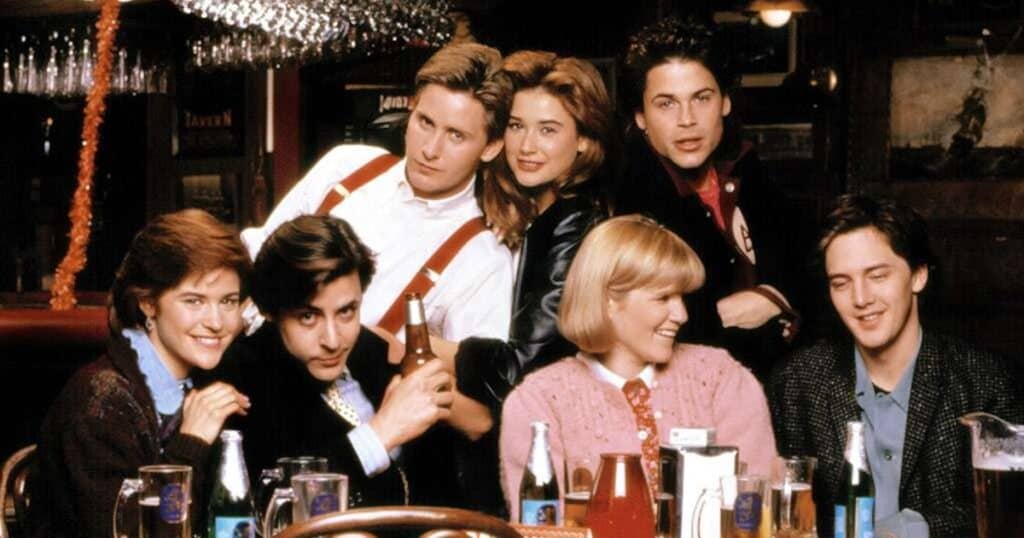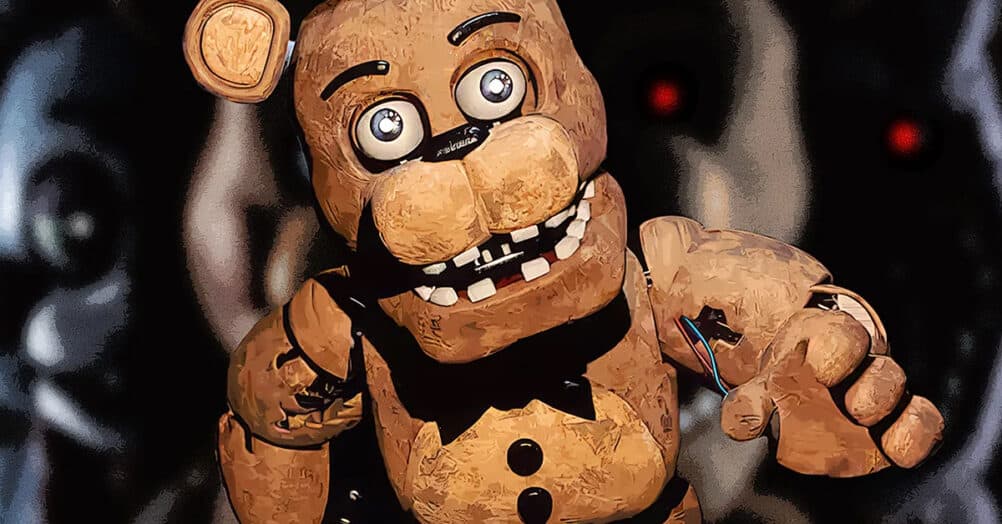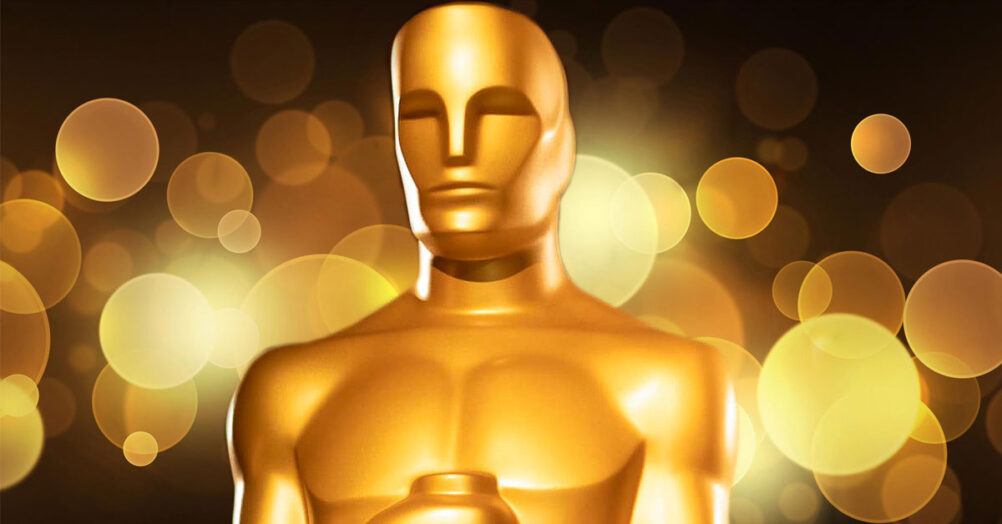Last Updated on September 25, 2024
If John Hughes’ The Breakfast Club remains the quintessential ‘80s Brat Pack movie, what ranks as a close second? If we’re talking headcount, Joel Shcumacher’s critically panned commercial hit St. Elmo’s Fire (which might be getting a sequel) tops them all. The movie follows a tight-knit group of seven Georgetown post-graduates navigating young adulthood and helped define the “Brat Pack” as a play on the fraternal friendship forged by Frank Sinatra and the Rat Pack in the ‘50s and ‘60s. In addition to advancing Schumacher’s directorial career, St. Elmo’s Fire partially launched the careers of stars Demi Moore, Judd Nelson, Ally Sheedy, Emilio Estevez, Rob Lowe, Andrew McCarthy, and Mare Winningham, most of whom would be associated with the Brat Pack for the next 40 years. The subject is documented in the new Hulu documentary, Brats, written and directed by McCarthy in a tender and touching snapshot of a special time in American coming-of-age movies.
Released four months after The Breakfast Club, St. Elmo’s Fire’s depiction of tenuous teenage friendship careening into adulthood has more heart and soul than the poor critical reviews may suggest. And just as crazy and unpredictable as its characters, the production witnessed its share of insane anecdotes, fun-filled factoids, and titillating trivia that may have eluded even the most die-hard fans of the film. You know what that means. Booga–Booga-Booga…Ha Ha Ha…it’s time to find out What Happened to St. Elmo’s Fire as the film approaches its 40th birthday!
St. Elmo’s Fire faced pushback since it was announced in the summer of 1984. According to director and co-writer Joel Schumacher, the script he wrote with Carl Kurlander, was rejected by several studio heads, stating: “A lot of people turned down the script…the head of one major studio called its seven-member cast ‘the most loathsome humans he had ever read on the page.’”
Columbia Pictures also hated the title, St. Elmo’s Fire, penning a 35-page screed explaining why it was such a terrible idea. Columbia even suggested the alternative titles, The Real World and Sparks. Ironically, the hit MTV reality series, The Real World, launched seven years after St. Elmo’s Fire, also focused on seven young adults living together and navigating personal and professional ups and downs. Speaking of living together, to play roommates in the film, stars Andrew McCarthy and Emilio Estevez roomed together before filming commenced to build their screen rapport.
Once Columbia Pictures green-lit the film, casting became the most important aspect of telling the story. According to Schumacher, hundreds of teens were interviewed for the seven major parts, the group of college graduates at the heart of the script. The studio quickly okayed the casting of 20-year-old Rob Lowe as Billy Hicks, the youngest cast member who was a teen idol in the mid-80s. Despite being underage, Lowe reportedly waltzed into his audition with a sixer of Corona in hand. Schumacher originally felt Lowe was wrong for Billy, but relented after Lowe’s agent bombarded him with persistence and an impassioned plea.

The studio also approved Ally Sheedy to play Lesie Hunter following her work in John Badham’s hit techno-thriller WarGames. Oddly enough, Columbia was also happy to cast Mare Winningham as Wendy Beamish, a teenage virgin who was not only 26 years old when the film was released, but was also pregnant while filming and already had one child. If you look closely, Wendy often crosses her arms, holds items in front of her stomach in wide shots, or is positioned behind cast members to conceal her baby bump in the movie. Other times, she is filmed sitting down or from above the waist.
While Columbia had no qualms about casting Lowe, Sheedy, and Winningham, Schumacher had to work hard to convince the studio to cast Judd Nelson as Alec Newberry and Emilio Estevez as Kirby Keager, despite their outstanding performances in The Breakfast Club and other movies. It was John Hughes who recommended the two actors, as well as Sheedy, to Schumacher. Sheedy also vouched for Nelson based on their Breakfast Club collaboration. Meanwhile, the casting of Demi Moore as Jules was a bit trickier.
According to Schumacher, he spotted Moore by chance in the hallway of his production office, which was located across the hall from John Hughes’ office. Schumacher implored a friend to track Moore down and ask if she was a professional actress despite starring in the daytime soap General Hospital. Once Moore was asked to audition for St. Elmo’s Fire, she rolled into the rehearsal on a motorcycle with the price tags still on her clothing. Much like her character Jules in the film, Moore was in the throes of a serious cocaine addiction while making St. Elmo’s Fire.
One day on the set, Schumacher noticed that Moore was launched out of her gourd on blow and demanded she leave immediately. Rather than firing her, Moore was ordered to attend rehab and vow to remain sober for the remainder of the shoot, despite playing a character with a drug habit. In her biography, Moore admitted to sniffing an eighth of coke every two days at the time and underwent 15 days of rehab treatment following Schumacher’s confrontation. Moore also admitted to having a drug counselor on the set with her each day of filming to maintain her sobriety.
Adding to the drama, Moore and Estevez began dating in real life while making the movie. Their relationship became so serious that they were briefly engaged to marry, although a wedding never happened.
The one glaring non-Brat Pack member, Andie MacDowell, who plays Kirby’s love interest Dale Bieberman, also had to be fought for by Schumacher. MacDowell has credited St. Elmo’s Fire for changing her life and career trajectory. In the DVD audio commentary, Schumacher attributes Kirby’s obsession with Dale to screenwriter Carl Kurlander’s experience as a college student. It’s also worth noting that Estevez initially expressed interest in playing Billy before he settled on portraying ol’ Kirbo.
As for actors almost cast, Robert Downey Jr. was eyed to play Billy Hicks before Lowe earned the part. Estevez’s co-star from The Outsiders, C. Thomas Howell, auditioned for the role of Kirby Keager but was deemed too young. Meanwhile, actresses up for the role of Jules included Jennifer Beals, Joan Cusack, Jodie Foster, and Tatum O’Neal. Before Sheedy was cast as Leslie, everyone from Jamie Lee Curtis, Bridget Fonda, Melanie Griffith, and Jennifer Jason Leigh to Sarah Jessica Parker, Meg Ryan, Brooke Shields, and Elisabeth Shue were considered.
Tangential Brat Packers Anthony Edwards and Lea Thompson were also up for unspecified roles. One of the more obscure casting tidbits includes Laura Dern nearly being cast as Naomi the sex worker before Anna Maria Horsford was chosen. Even more obscure, Mare Winningham’s brother Patrick appears as one of the New Breed band members during a party scene. As for Wendy’s parents, they are played by Martin Balsam and Joyce Van Patten, Hollywood veterans who were married in real life from 1957 to 1962.
Estimated with a $10 million budget, St. Elmo’s Fire began principal photography on October 15, 1984, and was quickly completed by Halloween. The rapid 16-day film shoot primarily occurred in Maryland and Washington, DC. Although the film is set around Georgetown University, the private Catholic college disallowed production to film on the campus, citing disturbing content such as drug use and premarital sex as reasons why. All the campus scenes in St. Elmo’s Fire were filmed 10 miles away at the University of Maryland in College Park, Maryland. Hence, the red and white Maryland Terrapin attire seen on campus rather than the blue and gray Georgetown colors.
The exterior of the St. Elmo’s Bar the college friends frequent was modeled after The Tombs in Georgetown. However, the bar’s exterior was filmed on a backlot at Universal Studios. An entire street was built to replicate Wisconsin Avenue in Georgetown. If you look closely, the iconic Hill Valley clock tower from Back to the Future is located a few doors to the left of St. Elmo’s Bar. Crazier yet, both movies were released five days apart in the summer of ‘85.
Additional filming occurred in Southern California, including various exteriors around the city and interiors at Paramount Studios in Burbank. The snowy scenes at the cabin where Dale and her boyfriend stay were filmed in Truckee, California.
Of course, one of the most memorable refrains from the movie is the group chant, “Booga-Booga-Booga-Ha-Ha-Ha,” which they share as a friendly in-joke that underscores their camaraderie. Get this, the chant was not in the script. Instead, it developed naturally among the cast members, who improvised the chant in response to outside gossip about the movie and the Brat Pack. Rob Lowe admitted the chant was created to make fun of whispering fans talking behind their backs.

Perhaps just as memorable as the Booga-Booga celebration, John Parr’s title track for St. Elmo’s Fire (Man in Motion) was not originally written for the film. Parr co-wrote the song to honor and raise funds for Canadian Paralympian Rick Hansen’s Man in Motion World Tour, who sustained a spinal cord injury during a car accident when he was 15. After the film’s release, Parr admitted the “Wheels” in “Man in Motion” referred to Hansen’s wheelchair but was mistaken by the public as a reference to Jules’ Jeep wheels in the movie. Despite finding inspiration for the lyrics elsewhere, “St. Elmo’s Fire” was written in 2 hours by Parr and the film’s composer, David Foster. Foster chose Parr to work on the film, although he is solely responsible for the instrumental piano theme. Despite being mandated by Schumacher not to mention St. Elmo’s Fire in the song, Parr did so anyway, necessitating Billy’s explanation to Jules about St. Elmo’s Fire being a meteorological event used by sailors to keep their spirits up.
Despite being hastily written and inspired by Hansen, St. Elmo’s Fire charted at number one on the Billboards Hot 100, remaining in the top position for two weeks in September 1985. Foster’s “Love Theme From St. Elmo’s Fire,” instrumental reached number fifteen. A music video was made for “Man in Motion” and serves as a semi-sequel, in which the actors reprise their roles (save for MacDowell) and return to St. Elmo’s Bar. Under Schumacher’s supervision, the music video was directed by Kort Falkenberg III.
Speaking of a return to St. Elmo’s Bar, the success of Andrew McCarthy’s documentary Brats in 2024 has led to Sony Pictures announcing an official movie sequel currently in development. While the plot details are unknown, all seven original stars are in line to reprise their roles, with MacDowell the only one yet to commit. Of course, Joel Schumacher passed away in 2020 after a battle with cancer and it will be difficult to find a director with the same connection with the actors and the material. But before digging deeper into a St. Elmo’s sequel, a closer look at the original film’s release and reception is in order.
Entering theaters on June 28, 1985, St. Elmo’s Fire became an instant commercial hit. The film turned its ten million budget into a thirty-eight million dollar moneymaker, launching the careers of its hot young stars, and Schumacher, who would go on to direct The Lost Boys in his follow-up film. Yet, despite the financial success, the movie was obliterated by film critics, most of whom cited the deeply deplorable and unlikeable characters for the movie’s lack of appeal. Rob Lowe won a Golden Rasberry Award for Worst Supporting Actor for his performance as Billy Hicks. Despite the movie’s popularity, the film still holds a paltry 35 Metascore and a 42% Rotten Tomatoes rating. In 2015, Consequence of Sound had the nerve to write a lengthy screed about why St. Elmo’s Fire is the worst movie ever made – a hysterical overreach of hilarious proportions that makes New York Times critic David Denby’s apoplectic review in 1985 seem rather tame.
Yet, looking at the audience reception, the film currently boasts a 6.4 IMDb score and 67% Rotten Tomatoes Audience Rating. The numbers suggest that, despite the characters’ insipid behavior, St. Elmo’s Fire is more enjoyable than its reputation may indicate. Yes, the characters are shallow, not too bright, and unsure of how to behave at such an impressionable age, but looking back, that is kind of the point of the piece. Older critics of the day may not have connected to the movie, but it resonated among the younger moviegoing crowds. Condemnable as the characters may be, few movies capture true, honest friendships like St. Elmo’s Fire.
In 2009, Sony announced plans to adapt St. Elmo’s Fire to the small screen as a TV series. Topher Grace pitched the idea through Sargent Hall Productions, which hired Dan Bucatinsky to write the pilot episode based on a concept approved by Schumacher. After lingering in development limbo for 10 years, NBC announced plans to make a St. Elmo’s Fire TV show in 2019. Although Josh Berman was tapped to write and produce, the project has yet to materialize.
And that brings us back to Brats. The documentary written and directed by Andrew McCarthy reunites several willing members of the Brat Pack, a punny description of the young actors who helped popularize the teen coming-of-age film in the 1980s. St. Elmo’s Fire features the most Brat Packers on record, with the six official members including Estevez, Lowe, McCarthy, Moore, Nelson, and Sheedy. “Brat Pack” was coined by David Blum in the June 10, 1985 edition of New York Magazine, which the participating members of the Brats documentary contemplate as a badge of honor and perjorative term. Members who appear in the doc include McCarthy, Estevez, Moore, Sheedy, and Brat Pack-adjacent members Lea Thompson, Jon Cryer, and Timothy Hutton. St. Elmo stars Judd Nelson, Mare Winningham, and Andie MacDowell do not appear in the doc. Nor do essential Brat Pack members, Molly Ringwald and Anthony Michael Hall.
Apart from the nostalgic blast from the past, Brats also explores the toll the media blitz had on The Brat Pack in the mid-80s, with the cast members explaining how the cultural phenomenon was both a curse and a blessing at once. McCarthy and Estevez come face to face to air out old grievances, but for the most part, it’s a fun-filled, heartfelt reflection on a bygone era in movies. Despite the members disliking being labeled as Brats at the time, McCarthy admits that the fans were correct to embrace the nickname. The real question becomes, how will audiences embrace a St. Elmo’s Fire sequel some forty years after the original? Until time tells the tale of the sequel’s fate, that’s What Happened to St. Elmo’s Fire. Despite depicting irredeemable youngsters navigating early adulthood, the film solidified The Brat Pack as a popular group of fresh-faced entertainers that would persist until the end of the decade. Yet, here we are 40 years later and the legacy still lives.
















Follow the JOBLO MOVIE NETWORK
Follow us on YOUTUBE
Follow ARROW IN THE HEAD
Follow AITH on YOUTUBE